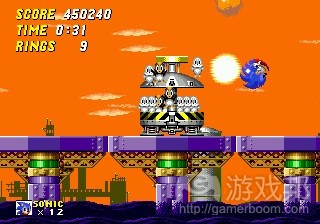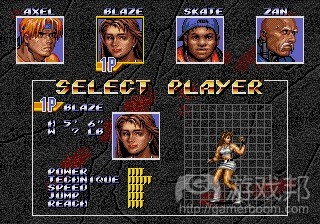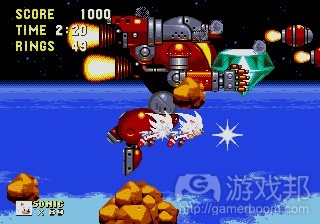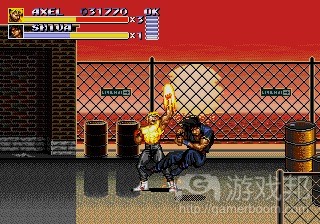分析iOS开发者可借鉴的世嘉游戏设计原则
作者:Sean Koch
8位游戏的重新发行及其在独立领域的复兴证明,电子游戏即使进入第15个或20个年头,它们依旧不会过时,无论它们是否算是杰作。作为一个在大学时代就步入游戏生涯,并在之后投身iOS领域的开发者,当初意识到iOS可能是我较为熟悉的领域时,我深为自己松了一口气。但我的触屏之旅略微不同。撇开巨大的价格差异、内容更新的重要性,以及IAP大战这些情况不谈,最让我不满的是App Store中有许多成功的游戏题材只是以制作价值取胜,但其玩法仍然非常基础。比起我从小玩到大的一些游戏,iOS游戏玩法真是太初级了。既然我要把这些现在已经变成“古董”的经典游戏作为对App Store产品的评价标准,那我就得先从一个铁杆玩家的角度来分析和解释为何这类游戏能够超越最低游戏设计标准。
当然, iOS平台存在各种不同题材和状态的游戏,现在我只讨论横向卷轴游戏。比如动作/冒险、射击、格斗、平台、跑步这些游戏,如果它们都涉及卷轴模式,那就都是本文观点讨论的范围。由于这类游戏的玩法容易上手,因此我乐意花大量的时间使用SEGA Genesis控制器(除美国人外,其他人称其为“Mega Drive”)体验这种题材的游戏。此控制器的图片和音乐效果看起来轮廓鲜明;从美学的角度上说,相对于超级任天堂系统这杯巧克力牛奶,Genesis好比是威士忌。这是因为世嘉控制器中的游戏来自这一行中那些最伟大的设计。世嘉的一些游戏伴我度过整个童年:比如《刺猬索尼克系列》、《Contra: Hard Corps》和《Streets of Rage 3》。我认为这三者可为iOS开发阐明4项产生深度的设计原则。
原则一:故事的重要性
我非常清楚,有些读者会认为这是在无病呻吟。许多开发者可能更想炫耀自己的编程能力,而不是他们的创意写作技巧,直言不讳的玩家可能会指出,国际象棋一开始就是靠游戏机制取胜。但我却能够证明那些伴随我多年的游戏,其共同点就是能够将我引进一个陌生的新世界。你可以使用多种方法重新设计跳跃按钮,但游戏场景、氛围、主题和信息才是赋予游戏独特本质的元素,它们能让玩家对此流连忘返。
最棒的是,你无需任何借助对话或描述性文本,就可在此讲述一个富有吸引力的故事或塑造一个令人难忘的世界。《刺猬索尼克》的1、2、3系列精通最小化故事情节的叙述技巧。所有玩家都知道,动物会吐出每个机器人,而刺猬要用它带刺的身体进行撞击,随着索尼克跟随Dr. Robotnik回到自己的巢穴,整个游戏环境变得更需技巧且更具深度。该款游戏以非常原始且容易消化的主题展开:动物对抗人类和机器。这么多年来,我一直是《索尼克》的忠实粉丝,原因就是游戏中的氛围与图画实际上向我传达了那个时代的精神。索尼克游戏代表着一种无畏强权的精神,它战胜了现实生活中看似难以克服的困难。
《Contra: Hard Corps》的故事情节则完全不同。Konami作出不可思议的设想:他们将猎获物记录簿同最高难度的射击游戏结合。在打败某些bosses后,你可以自由选择下一关卡,这有点类似于选择自己的冒险小说。这是个光荣的选择。该游戏内设四种不同的路径,每个路径中的阶段和bosses都独一无二。但是,Konami并非为了争夺奥斯卡奖项而叙写游戏中的疯狂情节。但类似于之前的《索尼克》,《Hard Corps》因纯粹的游戏氛围而创造不少价值。该游戏中,最引人注目的分支故事会让你感受到穿行在H.R. Giger的噩梦当中。甚至游戏中的Bosses也极具个性,他们会因玩家躲过了他们的攻击而大发脾气。
如果你想在不改变《Hard Corps》的前提下,将游戏中的潜台词转变为书面文本,你可以参照《Streets of Rage 3》。此游戏情节只有一个分支渠道通往结局,但它并非菜单选项——而且这完全取决于玩家的表现。
在游戏的第六回合,你需要在充满毒气的大楼内四处打探,寻找一个NPC,如果你没有及时赶到这个家伙的身边,他就会死掉。该游戏会根据玩家的结果以不同的关卡和最后的boss告终。为了收集分数你需返回到游戏的开端,所以你已经做好失败的准备,迎接这一糟糕的结局。你会感觉到一些压力!
原则二:多种角色可增加游戏重玩价值
在我看来,作为《刺猬索尼克3》的扩展版本,《Sonic the Hedgehog》依旧是电子游戏历史上的不朽之作。其中的原因之一是游戏角色玩法的独特性。在本系列里,配备各种能量盾牌的索尼克具有不同的特殊攻击能力。自然,他仍是两个角色中速度较快的那一个;而Knuckles仍需费力地爬上墙壁,用自己的拳头砸碎一些东西。目前,世嘉的游戏理念是,游戏会根据玩家扮演的角色设置不同的路径,基本上它会围绕每个英雄的特殊癖好塑造整个游戏体验。如果你扮演Tails,那么你就具有飞行能力,游戏就会呈现三种不同的风格形式供你选择。
《Hard Corps》为玩家提供了四个可选角色,并且每个角色都配备着自己独特的武器。Konami以创新方式把《Contra》的传统武器分配给各个角色,无论你扮演哪个角色,此方式都会促使这一系列的高手玩家略为失衡,同时为游戏注入一种完全不同的感觉。如果你用四个角色增加游戏中的四种途径……那我可能没有足够的时间可以完全体验游戏提供的扩展版本!
《Streets of Rage 3》在角色阵容上永居榜首。Axel是行动缓慢但力度强大的拳击手,Blaze能使出所有出色的招式,Skate因可以在屏幕之间穿梭而得名,Dr. Zan给人感觉像呆板的机器人。游戏中甚至设置了一些秘密角色,其中之一为袋鼠拳击手,如果你有足够的能力,那么你可以将其从那精神错乱的小丑师傅解救出来。我再强调一遍——你将在这款游戏中扮演一只怪异的袋鼠。该游戏中的每个角色都有完全不同的常规攻击、格斗和特殊攻击能力,这让每个战斗场景充满了新鲜感。直到我的Genesis游戏年代即将落幕时,我才意识到,如果你具备足够的能力,你还可以进一步挖掘每个角色的功能,而这是我下个原则将强调的问题。
原则三:为玩家提供真正值得追求的目标
我被迫在Game Center和OpenFeint汇报自己的战绩,因为这是现在时兴的做法,但老实说:我压根对这些成果不感兴趣,因为它们通常是显示在iOS平台上。当我每次努力完成一件值得关注的事情时,页面就会弹出消息窗口告诉我,我又为自己的Game Center战绩添上光辉的一笔,但我还有什么好说的呢,“谢谢”?不要误解我所表达的意思,在我看来,好友列表、玩家匹配以及排行榜的作用很大,但这些成就并不会为我带来小时候玩游戏获得成就的那种兴奋感。
每个成功的玩家首次目睹《刺猬索尼克2》中的索尼克转变为超级索尼克时,他们都会记住自己所在的位置,以及抛弃的附属品。他们曾为艰苦的隧道之旅感到绝望、艰苦、难过、生气,而他们在最后获得9000多分的奖励。世嘉的设计师必须找到其他渠道,提升《索尼克3》和《Sonic and Knuckles》中的赌注,再次突破原作的辉煌时代。虽然游戏中引入了Hyper Sonic这一俗气的角色,但是外太空的最后一战对骨灰级的玩家而言却永生难忘。
《Hard Corps》在这方面的表现并不出彩。我似乎记得,该游戏中的分数阈值会通过1-UP奖励保持玩家的生命值,但这属于老套的传统风格。目前,游戏领域盛行将角色的表现性能链接到故事分支:试想下,如果准确的射击能够决定第一回合的boss战斗后,Deadeye Joe是否可以幸免,那么玩家就会据此被引向某一条路径。
《Streets of Rage 3》为骨灰级玩家提供了一些特殊元素。当你到达某个高分数阈值,并未失去一次生命时,游戏中会发生一些神奇的事情:角色会开始释放出所有的激情,你甚至不知道他们聚集了这些情绪!角色以目前的生命值获得越高的分数,这种爆发效果会更加极端,角色生命栏中的小金星会显示出来。这样,该游戏对熟练的玩家来说就充满更多的挑战:角色发生更多进化,如果你无法应对这些快速变化,你就会遭遇更多敌人的攻击。玩家若失去一次生命,就会减少之前所得的表现星数;玩家就会为重获星数而沉迷于游戏之中。这种设置让游戏更为多变,从而增加了游戏的重玩价值。
原则四:添加变化可保持游戏生命力
此理念支持之前所述的所有原则,但值得注意的是,还有些额外方式也让这些游戏在深度上登峰造极。《刺猬索尼克》三部曲中的每部作品均向玩家呈现出极具挑战性的小游戏,丰富了横向卷轴动作游戏。《Hard Corps》沿袭了《Contra》自行车驾驶过程中的传统颠簸模式,以及惊心动魄的飞行阶段。
当然,开发者在扩展某款游戏的设计思路时,应该时时考虑用户的感受。《Sonic》、《Contra》和《Street of Rage》的附加模式均挑战了玩家的动作技能,这也是他们注册玩游戏的目的。
那么,是什么因素制约了iOS动作游戏的发展?
让我们面对这一现实吧:只有那些拥有大笔资金的团队和公司才能落实这些极棒的功能。尽管如此,iOS上仍有其他题材的游戏创造了掌机游戏般的深度,我也看到如果小型开发商再更进一步,也能够让预算有限的横向卷轴游戏实现同样效果。值得注意的是,独立开发社区内仍不乏8位游戏的支持者,所以,也许重新定义16位时代及其游戏设计发展是一件应该上升到文化高度的事情。也许游戏领域已有这个发展倾向,但用户对该类游戏的需求也应该跟上步伐。
我也同意用户界面设计是游戏关键障碍的说法。我们确实可以从Bow Mobile和世嘉的格斗游戏移植版本中看到这一现象,这两者在发行后期仍需设法处理控制问题,否则这些多按钮游戏就只能在App Store上承受舆论批评。我们现在陷入两难的境地,不是吗?如果资金有限的开发者在UI设计上过于冒险,那么他们就没有足够预算处理发行后的修复问题,但自动卷轴游戏或者只能左右移动这种不加修饰的游戏,最终又难免被埋灭在大把相似的游戏中。
但我所提到的游戏,没有一者的界面复杂度甚于今年的最佳iOS独立游戏。GitchSoft的《星际战队》证明了复杂的射击游戏随处可得。如果你正在进军App Store,那么你该认真看下Rotting Cartridge的《Kale in Dinoland》。《Kale》的界面在布局和可靠性上非常接近NES或者游戏控制器。确切来说,该游戏仍然只设置一个按钮,缺乏《Streets of Rage 3》中所需的特殊元素,但是,目前《Kale》已设置了四个虚拟的方向键。游戏中的主角可以瞄准居于他上面的敌人,可以让自己的坐骑上升或者下降。这是iOS平台上大多数横向卷轴游戏所缺失的元素!
如果游戏的场景设置在滚动的传送带,Kale可以在这场景中上下移动,轻轻一跳,实行空袭,而且游戏背景会恰当地配合玩家的格斗。按压同一方向键两次,可以引发角色的跑或猛冲,加上一个冲撞后的攻击?嗯,是的,我也见过这种动作。那么敲点屏幕也应该能够让小Kale完成一个翻筋斗的踢打动作,划动屏幕则可可让他发射一个火球。(本文为游戏邦/gamerboom.com编译,拒绝任何不保留版权的转载,如需转载请联系:游戏邦)
The Genesis of Great Game Design: Four Lessons From SEGA Classics
by Sean Koch
If there’s anything re-releases and the indie-resurrected 8-bit era have proven, it’s that videogames don’t become obsolete when they’re 15 or 20 years old. Not if they’re excellent.
As someone who put his gaming life on hold in undergrad before jumping headlong into the iOS industry on the press side, I drew a huge sigh of relief when I realized this; covering iOS would put me in very familiar territory, I figured. And yet, my touchscreen-powered journey has been alien in some ways. When I put aside the wide price differentials, the importance of content updates, and the simmering War on In-App Purchases, what nags at me is how much App Store success in certain genres has come down to muscling through with production values while gameplay remains pretty basic. Pretty basic, that is, compared to the very best of what I played growing up. Since I use now-fossilized classics as standards for evaluating what floods into the App Store, it’s only fair that I turn my love of digital dissection on these relics and explain what took them beyond the minimums of game design from one avid player’s perspective.
Different genres exist in very different states on iOS of course, so for now I turn my attention to side-scrollers. Action/adventure, shoot ‘em up, beat ‘em up, platformer, runner — if it scrolls, it rolls into the crosshairs of this opinion piece. Hands down, I spent the most time playing these genres with a SEGA Genesis controller (make that “Mega Drive” for our readers outside the US). It wasn’t for the graphics or music, which had something of a hard edge; aesthetically, the Genesis seemed like whiskey to the SNES’ chocolate milk. It was because SEGA’s console benefited from what must have been some of the greatest minds in the history of game design. A few titles in particular dominated way too much of my childhood: the Sonic the Hedgehog series, Contra: Hard Corps and Streets of Rage 3. Taken together, they illustrate four depth-generating principles that should be well within the iOS developer’s reach.
Lesson One: Story Matters After All
I know, I know, some readers will see that as a pretty groan-worthy statement. Lots of devs would probably rather show off their programming chops than their creative writing, and players who want to cut to the chase might point out that Chess has been getting away without a motivating glue beyond its gameplay mechanics for, like, eons. And yet, I can attest that the games and franchises I stuck with over the years were the ones that drew me into strange new worlds. There are only so many ways you can re-invent the jump button, but a game’s world, atmosphere, theme, and message — these are things that can give it a unique flair and keep it in the back of the player’s mind when he or she should really be finishing up some math homework.
The great news is, you can tell a catchy story or build a memorable world without displaying a single line of dialogue or descriptive text. Sonic the Hedgehog numbers one, two, and three mastered the art of minimalistic storytelling. All players really knew was that animals were popping out of every robot this hedgehog bopped with his spiny body, and that the game environments grew ever more mechanical and corrupted the deeper he followed Dr. Robotnik back to his lair. It was a very primal, easily digested theme: animal versus man and machine. The Sonic trilogy’s subject becomes especially ingenious when you consider the time period of its release: the 1990s were dominated by imagery of ducks getting tar pumped from their stomachs, a time when grade schools did their best to drive mortal fear into youngsters who didn’t recycle. A big part of why Sonic stuck with me so long is that its atmosphere and motifs effectively channeled the spirit of the era as I perceived it. So much the better that Sonic’s journey represented a vicarious victory over forces that seemed insurmountable in real life!
Contra: Hard Corps (Probotector for those who called their SEGA Genesis a Mega Drive) fell on the very opposite end of the spectrum. Konami did the unthinkable: they merged the gamebook with the hardest shoot ‘em up you could imagine back then. After certain bosses you’d get a choice of where to go next, and the result felt like a choose-your-own-adventure novel where you shot the pages to smithereens. It was glorious. There were four distinct paths through the game, with stages and bosses so unique that the urge to fire that console up again just to see them all was simply magnetic. Granted, Konami wasn’t in the running for any Academy Awards with the game’s bonkers plot. But like Sonic before it, Hard Corps pumped a lot of value out of sheer atmosphere. The most compelling story branches gave you the feeling you were playing through one of H.R. Giger’s nightmares. Bosses even had personality, appearing to throw temper tantrums as the player slipped through their attacks.
If you want to move from subtext to written text without going quite as far as Hard Corps, Streets of Rage 3 is a great example to look at. Its plot contained just one fork toward the end of the game as I recall, but that branch wasn’t a menu choice — it depended entirely on player performance. The sixth stage had you ferreting around a building filled with poison gas searching for an NPC, and the guy would die if you didn’t reach him in time. The game wrapped up with a different final level and end boss depending on the outcome. Since this was back before save points, you felt committed to follow through to the bad ending with the weight of failure on your mind. Nothing like a little pressure! Yes, that is a kangaroo in the linked video by the way, and that brings us to our next lesson.
Lesson Two: Multiple Characters Multiply Replay Value
Sonic and Knuckles, a physical expansion pack to Sonic the Hedgehog 3, remains the most monumental content update in the history of videogames in my opinion. One of the reasons why is that the title characters played so uniquely. By that point in the series, Sonic gained different special attacks when equipped with various energy shields, and naturally he was the faster of the two; Knuckles laboriously climbed up walls and busted through things with his fists. SEGA took the concept so far that your path through a level depended on which character you played as, essentially shaping the entire experience around each hero’s particular quirks. If you factor in Tails and his flying ability, that made three distinct playing styles you could adopt.
Thus, I remained loyal to a giant game three times as long as was probably healthy, ignoring whatever else happened to be on the market all the while.
Hard Corps gave you four player characters to toy with, each with his or her own exotic collection of weaponry. Konami did a really ingenious thing in spreading the traditional Contra weapons across characters, putting the series veteran a little off balance no matter who you played as and giving the game a very different feel each go around. And if you multiply the game’s four paths by four characters…wow. I didn’t even have enough time to play through every variation this game offered, and that’s saying a lot for a shoot ‘em up!
Streets of Rage 3 remains the champion of character rosters. Axel was your slow-but-powerful boxer, Blaze had all the cool moves, Skate earned his name by zipping around the screen, and Dr. Zan felt like the stiff cyborg he was supposed to be. There were even a few secret characters, one of them a boxing kangaroo you could rescue from his deranged clown master if you were good enough. Let me say that again – this game let you play as a freaking kangaroo. How awesome is that? Each character had completely different regular attacks, grapples, and special attacks, making every playthrough fresh. It wasn’t until the twilight of my Genesis gaming years that I realized you could push each character’s abilities a little further if you were especially skilled, but that’s for the next lesson.
Lesson Three: Give Players Something Really, Really Ridiculously Cool to Strive For
I’m compelled to report on Game Center and OpenFeint integration because these are expected nowadays, but if I may be completely honest: I’m underwhelmed with achievements as they’re often presented on iOS. Every time I pull off something noteworthy and a popup tells me I’ve added a new bragging right to my Game Center history, I kind of stare blankly at it and say, ”Thanks…I guess?” Don’t get me wrong — friend lists, multiplayer matchups and leaderboards have great utility, but the achievements themselves just don’t get me excited like the gameplay rewards I grew up with.
I tell you, every successful chaos emerald hunter remembers where they were, and what expletive they dropped, when they first witnessed Sonic turning into Super Sonic in Sonic the Hedgehog 2. A lot of blood, sweat, tears, and gnashing of teeth went into that tough-as-nails tunnel minigame, and the reward was over 9000 to match. The designers at SEGA had to figure out some way of upping the ante in Sonic 3 and Sonic and Knuckles and once again outdid themselves. The introduction of Hyper Sonic was tacky enough, but the apocalyptic showdown in outer space that came with it was a memorable treat for the expert player.
Hard Corps didn’t really do much in this area. I seem to recall that score thresholds helped keep the player alive through 1-UP rewards but that’s a well-worn genre tradition. Linking performance metrics to the story branches, now that would have been delicious: imagine if shooting accuracy determined whether Deadeye Joe survived to pop out of his exoskeleton after the first boss battle, and the player being ushered one way or the other based on that.
Streets of Rage 3 did have something special in store for the expert player. As you reached certain high score thresholds without losing a life, something strange and wonderful would happen: your character would start unleashing cans of whoopass you didn’t even know they could muster! The higher you scored on your current life, the more extreme this effect would become, indicated by little gold stars below your character’s health bar. Not that this necessarily made the game too easy for already skilled players: the more your character evolved, the more open you’d be to enemy counter attacks if you failed to master these on-the-fly changes. Getting ahead of yourself and losing a life would dock one of those precious performance stars; the quest to get it back could be utterly addictive. It was one more layer of variation on the main formula and that made it valuable.
Lesson Four: A Little Variety Goes a Long Way
This idea underpins everything discussed before, but it’s worth noting additional ways these classics scored high on the depth meter. Each game in the Sonic the Hedgehog trilogy presented a super-challenging minigame that gave players a break from the usual side-scrolling action. Hard Corps inherited the Contra tradition of tossing in bike riding and hold-on-for-your-life flying stages that are just as critical to the formula as all the cool guns. According to fansite Streets of Rage Online, an extra mode planned for Streets of Rage 3 sadly received the axe before release — but the game made do with a harrowing bulldozer chase sequence.
It’s important for devs to keep their audiences in mind when deciding how wide to cast their game design net in a single title, of course. The additional modes in Sonic, Contra, and Streets of Rage all tested the player’s action skills, which is what they signed up for; a round of Sudoku or a math puzzle sitting smack dab in the middle might not have gone over quite as well.
So What Holds Back iOS Action Games?
Let’s face it: all those awesome features were implemented by entire teams and companies that had some cash to burn. Nevertheless, other genres on iOS have managed to capture console-quality depth, and I’ve seen shoestring budget side-scrollers that could have done likewise if the dev had reached just a little further. It’s worth noting that there’s a love of all things 8-bit among the indie development community, so maybe reinterpreting the 16-bit era and its game design advances is just something that needs to be worked up to on a cultural level.
Maybe the inclination is there but the desire for it is something the consumer base needs to work up to.
I would also agree with those who note user interface design as a critical barrier. We can certainly see it in beat ‘em up ports by Bow Mobile and SEGA themselves, who’ve had to scramble to fix control issues post-release or let their multi-button titles sit on the App Store and weather storms of criticism. We’re left with quite the catch-22, aren’t we? Cash-strapped indies have much less luxury in the way of post-launch recoveries if they get adventurous with UI design, and yet every auto-scroller or game with no bells and whistles beyond right and left movement will blend into a sea of similar titles.
But I would propose that none of the games I’ve mentioned relied on interfaces much more complex than the best iOS indies have churned out this year. GlitchSoft’s Star Marine is evidence enough that complex shoot ‘em ups are well within reach. The Rotting Cartridge’s Kale in Dinoland is especially worth a good hard look if you’re just embarking on your own journey into the App Store. Kale’s interface is scarily close to an NES or Game Boy controller in terms of arrangement and reliability. It’s still one button shy of what’s needed for specials in
Streets of Rage 3, to be sure, but look at what Kale has already gained with its four-way virtual D-Pad. The main character can target enemies above him and make his rides climb and descend. That’s more than we can say for most side-scrolling heroes on this platform!
If placed in a belt-scrolling environment, Kale could move up and down the field, execute aerial attacks mid-jump, and context would take care of grapples. Double-pressing in one direction to run or dash, plus a dash attack? Mm-hmm, yep, I see those there too. And who’s to say a tap at the screen couldn’t make little Kale pull off a somersault kick, while a swipe makes him launch a fireball? What strange and wonderful things the future may hold!(source:ifanzine)
下一篇:阐述统计学在游戏设计领域的应用














































 闽公网安备35020302001549号
闽公网安备35020302001549号